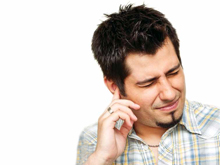Health Topics
-
Healthy Living
-
|
|
May 2011
|
| Trouble in the Tube |
| Dr.Jaswinder Singh Saluja |
| |
 |
Some people develop ear pain, especially when descending to land during a plane journey. This is caused by unequal pressures that develop on either side of the eardrum as the plane descends. On descending, the air pressure is higher near the ground. |
This pushes the eardrum inwards, which can be painful. In most people, just normal swallowing and chewing quickly causes air to travel up the Eustachian tube to equalise the pressure.
Some airlines offer sweets to suck and eat when the plane is descending - to encourage you to chew and swallow, in case you’ve wondered why they’re being so ‘sweet’. However, if you have a narrow Eustachian tube in the ear, a cold, or anything else that can cause blockage to the Tube, the pressure does not equalise very easily when the plane descends. This is what causes severe ear pain.
Ear Map
But before we get into the tube to understand more about particular conditions in the ear, it would be good to first have a road map.
- Our ear basically consists of three segments: the outer ear, the middle ear, and the inner ear.
- The outer ear leads through a one-inch long tunnel into the middle ear which is sealed from outside by the eardrum.
- Sound waves hit the eardrum. Vibrations of the eardrum pass on to tiny bones in the middle ear.
- These bones transmit the vibrations to the cochlea in the middle ear. Sound signals are sent from the cochlea to the hearing nerve and on to the brain. That’s how we hear, in case you wondered.
The Tube
The Eustachian tube is a narrow tube that connects the middle ear with the back of the nose. In adults it is about three to four centimetres long. The middle ear space behind the eardrum is normally filled with air. This air is constantly being absorbed by the cells that line the middle ear. So, fresh supplies of air are needed to get to the middle ear from time to time.
The Eustachian tube is normally closed, but opens from time to time when we swallow, yawn or chew. This allows air to flow into the middle ear, and any mucus to flow out. This keeps the air pressure equal on either side of the eardrum. Having equal air pressure on each side of the eardrum, and the middle ear free of mucus, enables the eardrum to work and vibrate properly which is needed to hear properly.
When Things Go Wrong
Eustachian Tube Dysfunction (ETD) refers to the condition where the tube is blocked or does not open properly. Air cannot get into the middle ear then. The air pressure on the outer side of the eardrum thus becomes greater than the air pressure in the middle ear. This pushes the eardrum inwards, which becomes tense and does not vibrate so well when hit by sound waves.
5 Symptoms
- Muffled or dulled hearing
- Ear pain, because the eardrum is tensed and stretched
- Feeling of fullness in the ear
- Tinnitus (ringing or buzzing in the ear)
- Dizziness
One or both ears may be affected. The symptoms can last from a few hours to several weeks or more. It depends on the cause. In most cases, due to cold, the symptoms are likely to go within a week or so. As symptoms are easing, you may get pooping sensations or noises in the ear. Also, the dulled hearing may come and go for a short time before getting fully back to normal.
4 Causes
- Colds and other ear, nose (sinus) or throat infections
- Glue ear, where the middle ear fills with glue-like fluid instead of air
- Allergies
- Compression of the Eustachian tube because of enlarged adenoids. Tumours that develop at the back of the nose can also be the cause, though very rarely.
|
Helping Your Ear
- To help soothe your ear pain, while descending on a flight – which is where we started our ear story from – try these:
- Try to get air to flow into the Eustachian tube. This can happen if you swallow (drinking sips of water at frequent intervals) during descent.
- Try staying wake during landing and not taking sedatives during long distance flights.
- You can also chew a gum - or yawn!
- Medications like decongestants nasal spray/drops can be used during the flight.
- Antihistamine/decongestant tablets can be taken one or two hours prior to the scheduled flight.
|
 |
Dr.Jaswinder Singh Saluja is Senior Consultant - ENT, Head & Neck Surgery,Apollo Health City, Hyderabad |
|
|